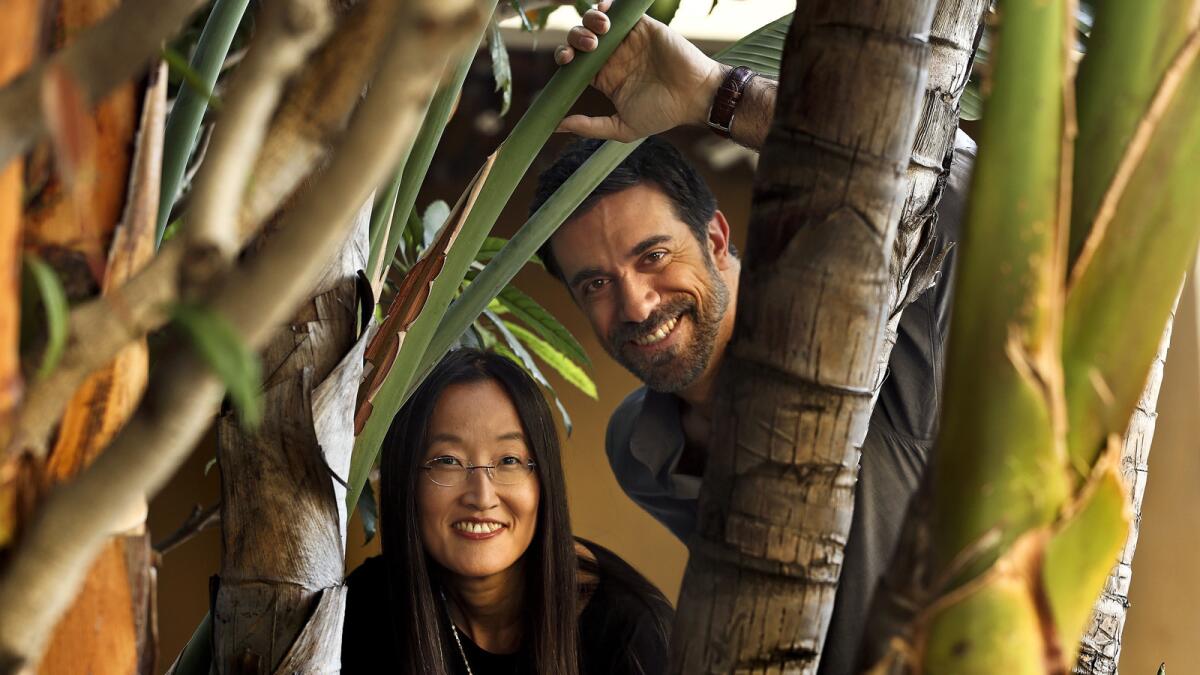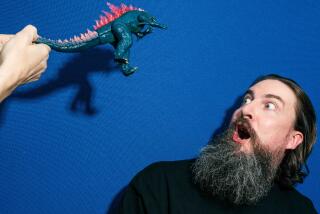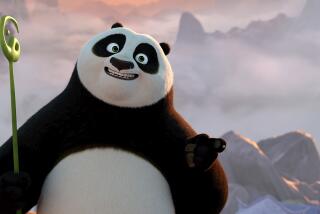‘Kung Fu Panda 3’ directors made sure every word translated into English and Mandarin -- ‘Skidoosh!’

Jennifer Yuh Nelson and Alessandro Carloni share directing credit on “Kung Fu Panda 3,” animated in English and Mandarin.
The idea for one of the most ambitious collaborations to date between China and Hollywood didn’t come from an embassy office in Washington or Beijing, or from a power lunch in Beverly Hills, but from a bunch of Bruce Lee fans brainstorming in the San Fernando Valley over a decade ago.
“We were just trying making a movie about kung fu ‘cause we liked kung fu,” said “Kung Fu Panda 3” director Jennifer Yuh Nelson, who served as head of story on the first “Kung Fu Panda” and has shared directing duties on the last two films. “We never thought of it as a business decision.”
With China set to become the largest film market in the world by 2017, if it wasn’t a business decision at first, it is now. “Kung Fu Panda 3” is the first movie to be animated in both English and Mandarin, and the first coproduction between Glendale-based DreamWorks Animation and its Shanghai-based venture, Oriental DreamWorks.
See more of Entertainment’s top stories on Facebook >>
The most ardent audiences for the films about a pudgy panda named Po have been in China, and the latest installment, which opened simultaneously in the U.S. and China on Friday, is no exception: The well-reviewed movie (80% on Rotten Tomatoes) made a respectable $41 million domestically in its opening weekend but a far more impressive and record- breaking $58 million in China, where its release was timed to the Chinese New Year.

The directors behind “Kung Fu Panda 3” discuss the challenges and beauty in creating a Mandarin and English version of the film.
“Not only did they like the first movie in China, but they said it felt very Chinese,” Yuh Nelson said. “That was a huge shock to us. We didn’t even expect anyone to see it there. So when everyone else started trying to find content for China, we just kept doing what we were doing.”
Domestically, audiences in several markets, including at L.A.-area theaters in Monterey Park, Tustin and Puente Hills, have had the option of seeing the movie in either language.
For Yuh Nelson and her co-director, Italian-born Alessandro Carloni, the dual languages added a layer of complexity to the $140-million production, and Chinese crews brought a new level of authenticity.
Though animated movies are commonly dubbed in many languages, “Kung Fu Panda 3” is fully animated in Mandarin, with the characters’ movements synced to deliver the Chinese dialogue properly. Translators had to tackle linguistic dilemmas such as Po’s signature nonsense word catchphrase, “Skidoosh” — “Zou-ni” in the Chinese version, which, loosely translated, means “Charge!”
Not only did they like the first movie in China, but they said it felt very Chinese.
— Jennifer Yuh Nelson, “Kung Fu Panda 3” co-director
With the latest movie, which was written by Jonathan Aibel and Glenn Berger, the filmmakers expanded the story of Po, the unlikely kung fu warrior voiced by Jack Black, into new visual and spiritual territory. In “Kung Fu Panda 3,” Po, who was raised by a goose, finally meets his birth father and gets a chance to see where he comes from, a lush and misty mountain town called Panda Village, where plump, lazy bears lead happy lives of dumpling eating and ribbon dancing.
Though the first two films were grounded in practical kung fu — or as practical as kung fu practiced by a panda can be — this one has sequences set in the spirit realm and deals with the Chinese concept of chi, or life force.
On the first movie, which came out in 2008 and earned $215 million domestically and $416 million overseas, the American filmmakers relied on the Internet and books for their research into Chinese culture, but this time they had access to hundreds of Chinese artists who politely informed them when they went wrong. One character’s costume combined elements of different dynasties — a fashion no-no. Another left chopsticks sitting on the bowl, also a faux pas.

“Kung Fu Panda 3” made $41 million domestically in its opening weekend but a far more impressive and record-breaking $58 million in China. Pictured are co-directors Alessandro Carloni, left, and Jennifer Yuh Nelson.
Teng Huatao, a TV and film director in China, came aboard as consulting director to helm the Chinese language version of the film. Among his tasks was directing Jackie Chan, who has voiced the part of a monkey kung fu master in the English versions of the films and takes on an additional role as Po’s father in the Mandarin version. Chan speaks Mandarin with a pronounced Hong Kong accent, which he enlisted a voice consultant to help him lose for the Mandarin version.
“Eventually, I asked the consultant to stop coming, because I wanted the audience to recognize Jackie’s voice and I was worried that if he was too concentrated on his pronunciation, he would not focus enough on conveying the emotions,” Teng said.
On her first trip to meet the Shanghai artists, many of whom were fresh out of college, Yuh Nelson got an indication of how seriously they took the endeavor when the crew all showed up in traditional Chinese ceremonial outfits. While making the movie, artists from the two crews intermingled often — during brainstorming, a group from Oriental DreamWorks embedded in Glendale with a translator, and during production, the two crews connected daily via video conference.
Yuh Nelson, whose family immigrated from South Korea to California when she was 4, said she found a point of cultural connection in the popularity of Korean pop music and movies in China.
“I think they were a little disappointed that I wasn’t Chinese,” Yuh Nelson said. “But the fact that I was Asian meant that they found a point of similarity.”
As animators, Yuh Nelson and Carloni are a study in contrasts — she is soft-spoken but direct and excels at kinetic action scenes. He’s gregarious, with a knack for expressive characters. They found that artists in China and English speak a certain universal language, however, communicating easily via visuals.
The Chinese crews brought suggestions, like the toys the baby pandas in the movie might play with, and they had questions for their American colleagues.
“They wanted to know, ‘Why do Western audiences find anything about China interesting?’” said Yuh Nelson. “They were completely mystified. They thought it would be so alien for us, we wouldn’t understand it.” They were also curious to learn a formula for humor, Yuh Nelson said, a question she struggled to answer.
In some cases, the English language humor just couldn’t be replicated. Admiring his father clad in armor in one scene, Po says in English, “Wow, I think I just peed a little!” In the Chinese version, he says, “You look too handsome!”
Times staff writers Julie Makinen and Nicole Liu contributed to this report.
More to Read
Only good movies
Get the Indie Focus newsletter, Mark Olsen's weekly guide to the world of cinema.
You may occasionally receive promotional content from the Los Angeles Times.







